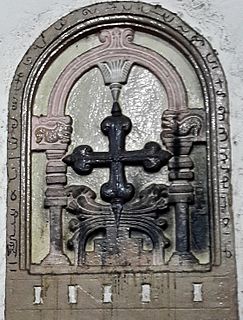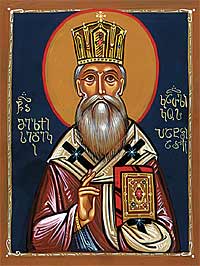
Bartholomew I is the 270th and current archbishop of Constantinople and ecumenical patriarch, since 2 November 1991. In accordance with his title, he is regarded as the primus inter pares in the Eastern Orthodox Church, and as the spiritual leader of the Eastern Orthodox Christians worldwide.

The Malankara Orthodox Syrian Church (MOSC) also known as the Malankara Church and the Indian Orthodox Church, is an autocephalous Oriental Orthodox church based in Kerala, India. The church serves India's Saint Thomas Christian population. According to tradition, the church originated in the missions of Thomas the Apostle in the 1st century.
Freedom of religions in Georgia is provided for by the country's constitution, laws, and policies. In practice, the Georgian government generally respects religious freedom; however, the Georgian Orthodox Church enjoys a privileged status in terms of legal and tax matters, involvement in public schools, and property disputes. There have been efforts by private citizens, local government officials, and local Georgian Orthodox Church leaders to harass and persecute members of minority religious groups and interfere with their worship activities; despite calls for tolerance and respect for pluralism by government leaders, the Georgian central government has not been successful in preventing such incidents.

The Syriac Orthodox Church, officially known as the Syriac Orthodox Patriarchate of Antioch and All the East, and informally as the Jacobite Church, is an Oriental Orthodox church, that branched from the Church of Antioch. The bishop of Antioch, known as the Patriarch, heads the church, claiming apostolic succession through Saint Peter in the c. 1st century, according to sacred tradition. The church upholds miaphysite doctrine in Christology, and employs the Divine Liturgy of Saint James, associated with James, the "brother" of Jesus. Classical Syriac is the official and liturgical language of the church.

The Apostolic Autocephalous Orthodox Church of Georgia, commonly known as the Georgian Orthodox Church or the Orthodox Church of Georgia, is an autocephalous Eastern Orthodox church in full communion with the other churches of Eastern Orthodoxy. It is Georgia's dominant religious institution, and a majority of Georgian people are members. The Orthodox Church of Georgia is one of the oldest churches in the world. It asserts apostolic foundation, and its historical roots must be traced to the early and late Christianization of Iberia and Colchis by Saint Andrew in the 1st century AD and by Saint Nino in the 4th century AD, respectively. As in similar autocephalous Orthodox Christian churches, the church's highest governing body is the holy synod of bishops. The church is headed by the Catholicos-Patriarch of All Georgia, Ilia II, who was elected in 1977.

St. Ambrosius was a Georgian religious figure and scholar who served as the Catholicos-Patriarch of All Georgia from 1921 to 1927. Best known for his opposition to the Soviet regime, he was canonized in 1995 by the Georgian Orthodox Church as Saint Ambrosius the Confessor.
Catholicos, plural Catholicoi, is a title used for the head of certain churches in some Eastern Christian traditions. The title implies autocephaly and in some cases it is the title of the head of an autonomous church. The word comes from ancient Greek καθολικός, pl. καθολικοί, derived from καθ' ὅλου from κατά and ὅλος, meaning "concerning the whole, universal, general"; it originally designated a financial or civil office in the Roman Empire. The name of the Catholic Church comes from the same word - however, the title "Catholicos" does not exist in its hierarchy.

Alphabetical list of Eastern Christianity-related articles on English Wikipedia

The Kingdom of Abkhazia, also known as Abasgia or Egrisi-Abkhazia, was a medieval feudal state in the Caucasus which was established in the 780s. Through dynastic succession, it was united in 1008 with the Kingdom of the Iberians, forming the Kingdom of Georgia.
The Catholicate of Abkhazia was a subdivision of the Georgian Orthodox Church that existed as an independent entity in western Georgia from the 1470s to 1814. It was headed by the Catholicos, officially styled as the Catholicos Patriarch of Imereti, Odishi, Ponto-Abkhaz-Guria, Racha-Lechkhum-Svaneti, Ossetians, Dvals, and all of the North. The residence of the Catholicoi was at Bichvinta in Abkhazia, but was moved to the Gelati Monastery in Imereti in the late 16th century. In 1814, the office of the Catholicos of Abkhazia was abolished by the Russian Empire which would take control of the Georgian church until 1917.

George the Hagiorite was a Georgian monk, calligrapher, religious writer, Theologian and translator, who spearheaded the activities of Georgian monastic communities in the Byzantine Empire. His epithets Mt'ats'mindeli and At'oneli, meaning "of the Holy Mountain" (Hagiorite) and "of Athos" respectively, are a reference to his association with the Iviron monastery on Mount Athos, where he served as hegumen.

Today 84% of the population in Georgia practices Orthodox Christianity, primarily the Georgian Orthodox Church. Of these, around 2% follow the Russian Orthodox Church, around 5.9% follow the Armenian Apostolic Church and 0.8% are Catholics and are mainly found in the south of Georgia but with a small number in its capital, Tbilisi.

Catholicos of the East is an ecclesiastical title historically used by the Church of the East. The term "Catholicos" is derived from the Greek word Katholikos (Καθολικός), meaning "Universal Bishop".
The Church of Albania or the Albania Apostolic Church was an ancient, briefly autocephalous church established in the 5th century. In 705, It fell under the religious jurisdiction of the Armenian Apostolic Church as the Catholicosate of Aghvank centered in Caucasian Albania, a region spanning present-day northern Azerbaijan and southern Dagestan.

The history of the Filioque controversy is the historical development of theological controversies within Christianity regarding three distinctive issues: the orthodoxy of the doctrine of procession of the Holy Spirit as represented by the Filioque clause, the nature of anathemas mutually imposed by conflicted sides during the Filioque controversy, and the liceity (legitimacy) of the insertion of the Filioque phrase into the Nicene Creed. Although the debates over the orthodoxy of the doctrine of procession and the nature of related anathemas preceded the question of the admissibility of the phrase as inserted into the Creed, all of those issues became linked when the insertion received the approval of the Pope in the eleventh century.

Domentius IV was the Catholicos Patriarch of Georgia from 1705 to 1724 and again from 1739 to 1741. He was a member of the royal Mukhrani branch of the Bagrationi dynasty, born as a younger son of Levan of Kartli and his first wife Tuta Gurieli. Domentius was energetically involved in the politics of Kartli and, according to some contemporary accounts, he even had regal ambitions. The split in his patriarchal tenure was due to his opposition to the accession of the Ottoman regime in Kartli and he spent thirteen years in the Ottoman captivity from 1725 to 1737. A man of letters, Domentius compiled a collection of Georgian hagiography. He also sponsored reconstruction and repair of several churches and monasteries in Georgia. His regnal name is sometimes given as Domentius III.
Basil, son of Bagrat was an 11th-century Georgian monk and man of letters in the Kingdom of Georgia, frequently identified as a son of King Bagrat III. He was active at the Khakhuli Monastery. He is a saint of the Georgian Orthodox Church.

Several historical evidences shed light on a significant Malankara–Persia relationship that spanned centuries. While a fraternal relationship existed between Malankara and Persia in the earlier centuries, closer ecclesiastical ties developed as early as 15th century and endured until the Portuguese colonial invasion of Malabar in 16th century. The Christians who came under the two ancient yet distinct lineages of Malankara (India) and Persia had one factor in common: their Saint Thomas heritage. The Church of the East shared communion with the Great Church until the Council of Ephesus in the 5th century, separating primarily over differences in Christology.













